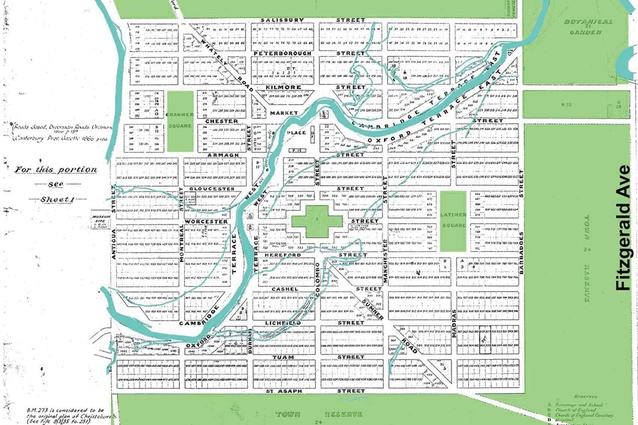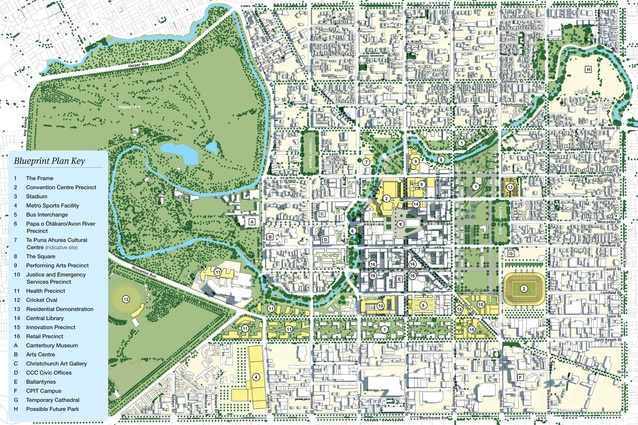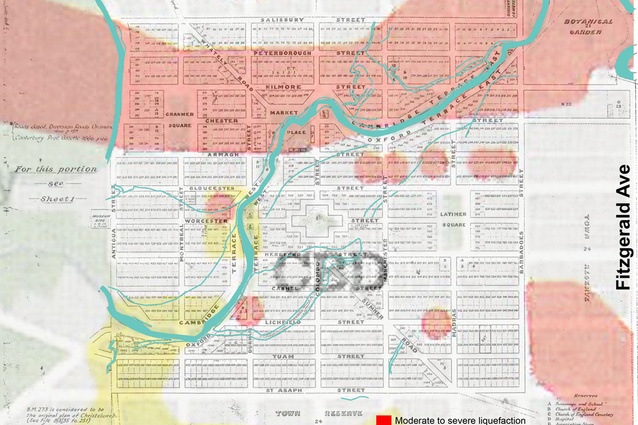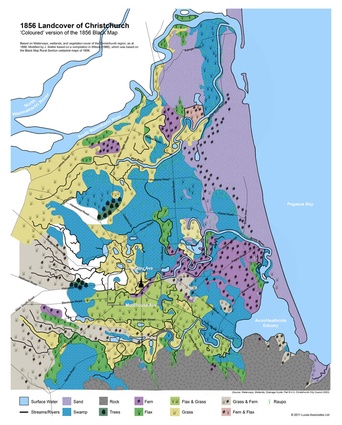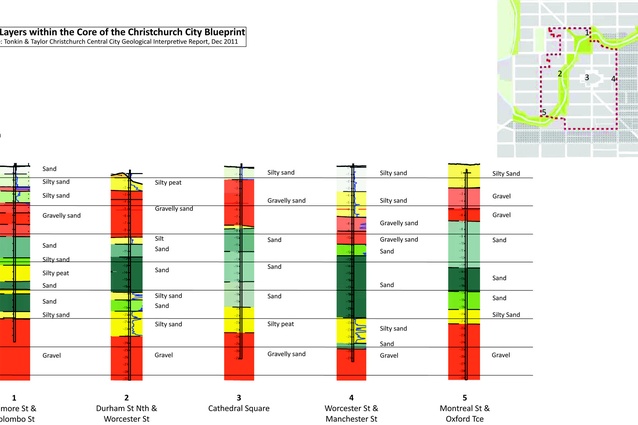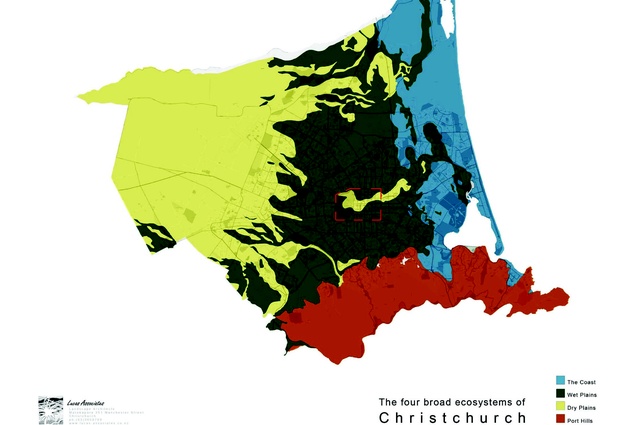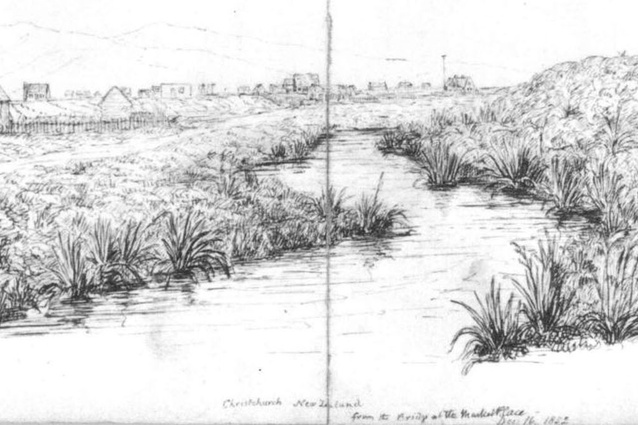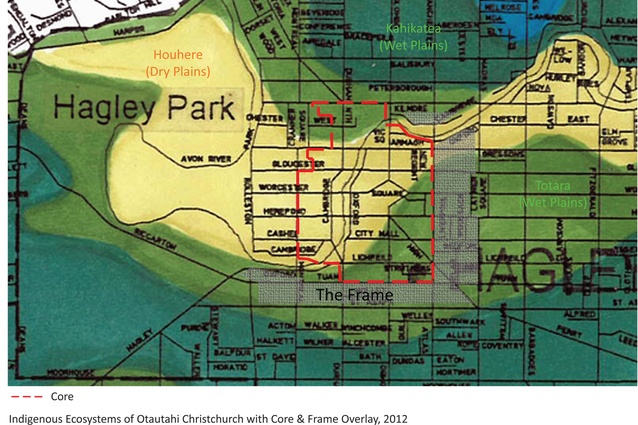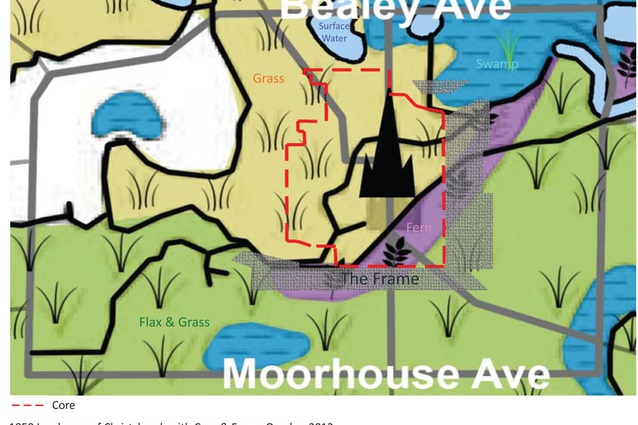Framing the central city: again
A green frame for Christchurch City? It’s a concept that’s been tried – and lost – before. The key to success, argues Di Lucas, is retaining the size of the ‘band’.
I doubt a design drawing a wide green band to confine central city construction was as hot a topic in 1850 as it is in 2012. Both the 1850 ‘Town Reserve’ and the 2012 (Christchurch Recovery Plan) Blueprint’s ‘Frame’ around the city core are visionary and brave. The old Town Reserve was gone by 1862. The new Frame has hundreds of owners, myriad demolition sites as well as a scatter of usable, repairable and new buildings – and legal challenges. For urban design success, a substantial green band needs to be secured. It’s not often you get this second chance. But with underlying ‘Business Zoning’ we again risk losing the band’s green dimensions long term.
1850 Plan
Deciding to select this thousand acres for the Canterbury Association’s settlement in 1849, advantages for Captain Thomas included the dry and level land, a handy forest (Papanui), and the site adjoining a navigable river with water “clearer than crystal”.
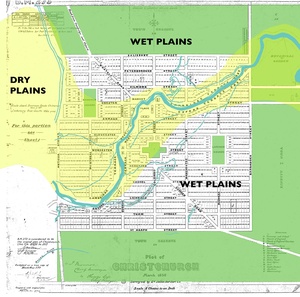
In 1850, the banded area centring on Cathedral Square involved a core area of dry land – grass, fern and tutu – with wetlands to north, east and south largely within the Town Reserve. The lush kahikatea and totara forests of the wet plains reported by Waitaha, and the dry plains houhere forest, had all long gone. However their stumps are regularly evident during site excavations and deep piling throughout the central city. Assistant Surveyor Edward Jollie sought that the park belt enframing the centre provide separation from suburban development to the north, south and west. No expansion east was intended.
Waimakariri river floodwaters naturally flowed along the Otakaro/Avon on occasion. Whilst stop-banked out many decades ago, a lobe of gravels left from such floods remains evident through the city. This forms the lobe of dry plains land within the central city. Our 1995 mapping of Christchurch ecosystems showed a lobe of dry plains through the city centre, surrounded by naturally wet plains. Drill data shows the core is on gravels, it is not on the deep soft ground found beyond, where gravels to support foundations may be 20m down.
Reacting to the social disparity and poverty of industrial Britain, the encircling green band in Jollie’s 1850 design was a therapeutic recreational space to achieve the “Greatest Health for the Greatest Number”. Providing breathing places through public parks and environmental reform was central to such ‘Benthamite’s’ approach. Hagley Park, a suite of squares, the river and green band were proposed. The green band was intended to:
- Improve the environment for the working class;
- Separate urban and rural;
- Control city expansion;
- Guard against and protect the natives; and,
- Transplant the British landscape.
The plan inspired Frederick Law Olmstead who designed New York’s Central Park in 1858. The 1850 design has been respected in the central city’s recent Blueprint by the Boffa Miskell-led consortium. The grid with its viewshafts and clear sense of orientation is retained around the Avon corridor and suite of squares – Cathedral, Victoria, Cranmer and Latimer. But the grid could perhaps be twisted or “stuffed” to baffle the debilitating easterly wind.
The original major entrances via the diagonals from north-west (Papanui Road and Victoria Street) and south-east (Ferry Road and High Street) are also retained. With the 1980s hotel that blocked the route now demolished, Victoria Street (formerly Whately Road) can again be a major pedestrian route into the multi-valued Victoria Square (formerly Market Place). Sadly, the area as centred on the important mahinga kai and kainga of Puari and Tautahi was not recognised in the 1850 design, but is now sought to be rectified in the post-colonial vision.
The original broad encircling green band has been reduced to a feeble and fragmented median strip along the avenues. This time a broad green band is clinched in, to encircle a smaller city core, with the intent including to:
- Redefine the central city;
- Provide an attractive location for a range of commercial and residential activities;
- Articulate the community vision for a green, distinctive, vibrant and accessible city;
- Add visual and open space amenity; Gets people back into the city to enjoy walking, cycling and playing, and links with Hagley Park and the Otakaro/Avon River; and,
- Provide an attractive campus style environment for businesses.
Spring-fed lands
Christchurch central is spring-fed land. With the water table merely 1.5m to 2m below the surface, springs emerge where there is opportunity and naturally flow to the Avon. Allowance for previously blocked springs that arise again with building site works needs to be factored in to rebuild plans.
Post-quake, a gentleman phoned me to say that in 1937 he worked in the Transport Office in Cathedral Square and his first duty each morning was to fill his boss’s silver water bottle from a gushing spring in the basement of the adjoining Dalgety building. The Christchurch City Art Gallery proudly proclaims it’s location on a spring – Te Puna o Waiwhetu (puna = spring of water). Sadly, those spring waters are not evident, but piped away. Yet springs, streams and wetlands were not only previously useful, as in filling water bottles, but are also the tantalising assets of modern environmentally sensitive cities. They are the natural assets of the central city. Rather than piping waters away and pretending dry land, waters are increasingly displayed in ways that seek to emulate natural processes such as with stormwater cleansing through riparian buffers, rain gardens, swales and day-lighted streams. These become core features of city redevelopment.
Central city Christchurch had an abundance of natural springs and streams that were previously blocked and piped. Dry land was pretended. To merely place the names of buried waters onto new places is not enough. Around 15 years ago Christchurch City Council began a wonderful programme of wetland and waterway restoration. Regrettably, in recent years this work has not been given priority. Just as downtown Wellington and Auckland waterfronts proudly reveal their waters, Christchurch lagged in its programme. With an almost total rebuild of so much of central Christchurch now needed, there is opportunity to reveal and nurture natural ground waters as well as treat rainwater more naturally. The city’s recovery plan states this intent and we hope to see it as reality on public and on private land.
The City Council in 2000 approved a strategy to “Recognise that the numerous spring-fed tributaries of the Avon River are an essential part of the character of Christchurch”, and to “Sustain spring flows through restoration, groundwater management and monitoring.” Sadly more than a decade later the City Plan remains silent on springs. As they emerge in the re-build, the magnificent flows are again being blocked up or diverted into stormwater pipes. The Recovery Plan seeks to protect and enhance springs and waterways but methods are needed.
A confined city core in this naturally spring-fed land with high water table has opportunity for a modern garden city with tantalising lakes, wetlands, pools and streams. It is important the Papa o Otakaro/Avon River Precinct is not treated merely as a cultural heritage and amenity feature, but that the corridor and the catchment is addressed as a spring-fed natural system.
Land quality
The liquefaction mapping shows that, excepting along the riparian corridors, there was scant liquefaction on dry plains lands. The natural levees ruptured dramatically along both existing and previous natural waterways – where streams had been diverted into pipes decades ago, their abandoned levees still erupted.
The Central City charrette I ran in 1995 sought low-rise development, with the tree height along the river corridor, Hagley Park and the Avenues, setting a height threshold, so that buildings would remain visually contained within a green framework.1 At that time the Council sought an 80m height limit in the city centre, but with community opposition it has been variously lowered since. The Recovery Plan seeks low rise.
From its beginning in 1897, the Christchurch Beautifying Association sought to make Christchurch a garden city as much through the use and celebration of the New Zealand flora as through the use of garden plants imported from around the world. The Recovery Plan continues this with the plan proposing more natural cover on the central true left with more structural landscape development on the true right (south) bank.
Immediately following the February quake I was urged by colleagues in Japan to work to protect and nurture the original design concept for Christchurch. They recognise this city as an important international model. In many aspects the Recovery Plan’s Blueprint is respecting and advancing that model.
Footnote: 1. The Shape of Christchurch within the frame of the four avenues. A plan developed through the inner city charrette. Lucas Associates. November 1995.

